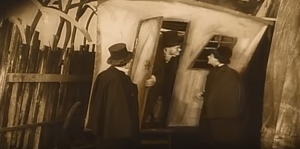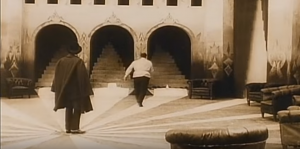The style of architecture featured in the sets of The Cabinet of Dr. Caligari is emblematic of German expressionism. As a movement aimed at externalizing internal thoughts and emotions, it is not surprising that the mise-en-scène — and sets by extension — would serve as a reflection of the events in the plot. The sets used in the film not only consistently externalize the emotions felt in the scene, but the events in the plot as a whole. With most of the film’s events occurring within the mind of a deranged patient, the lack of right angles and rectangular, symmetrical architecture shows the state of madness.
The asylum compared to the hallucinations of Francis
The only time in Caligari when straight lines in doorways and buildings are visible is towards the end of the film, inside the asylum. While an ironic place to find symmetry and order, this contrast from the style in which the rest of the town is depicted shows the difference between the hallucinations of the protagonist and the reality of the world. As an expressionist film, The Cabinet of Dr. Caligari has indeed expressed the inner thoughts and emotions of Francis in every way possible — especially in the world around him.


